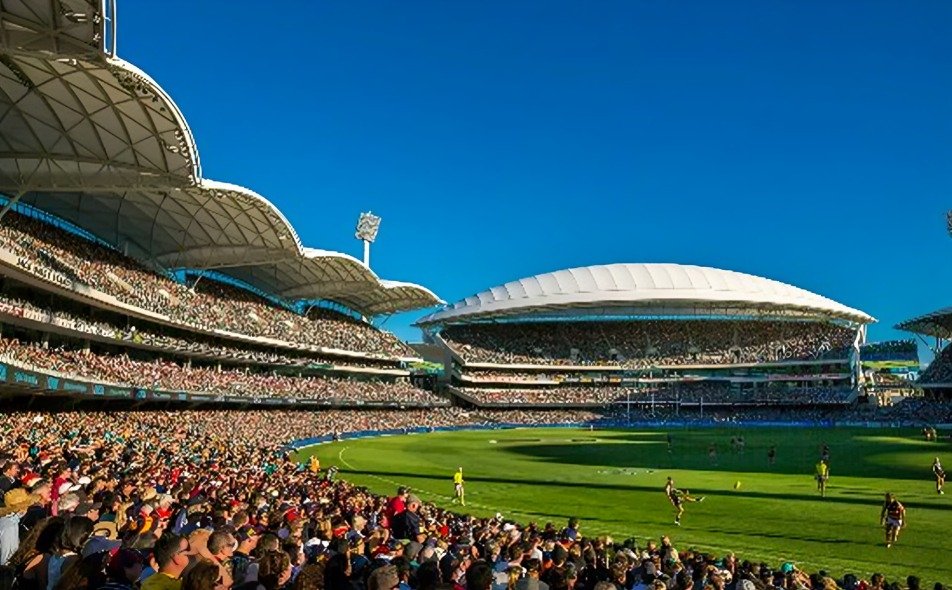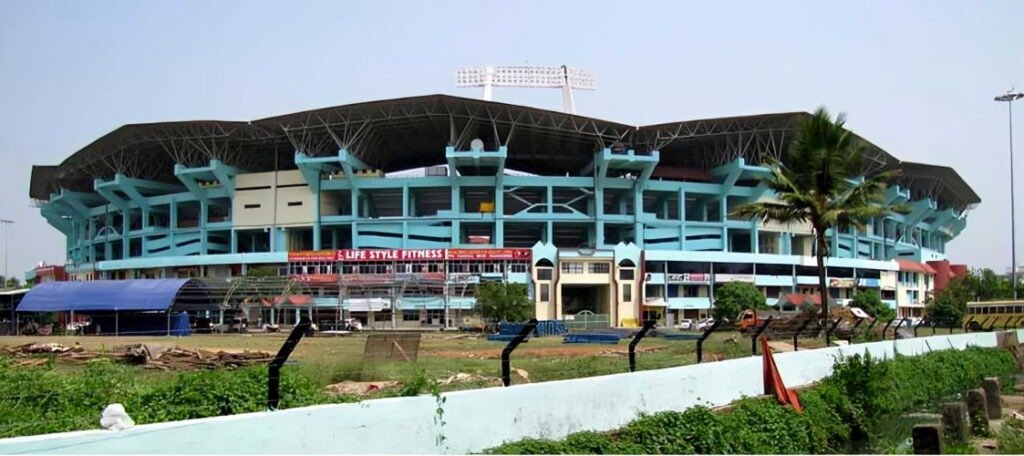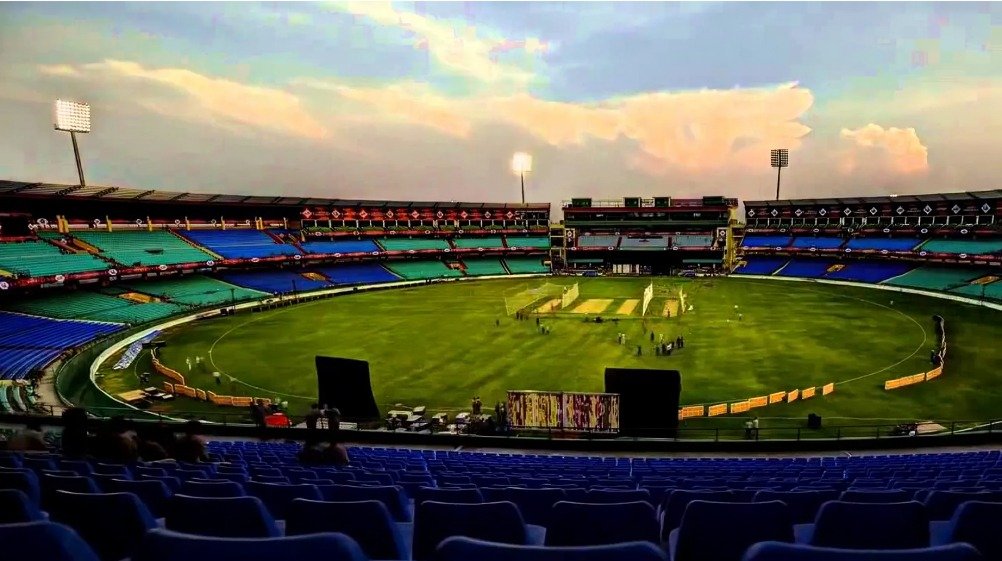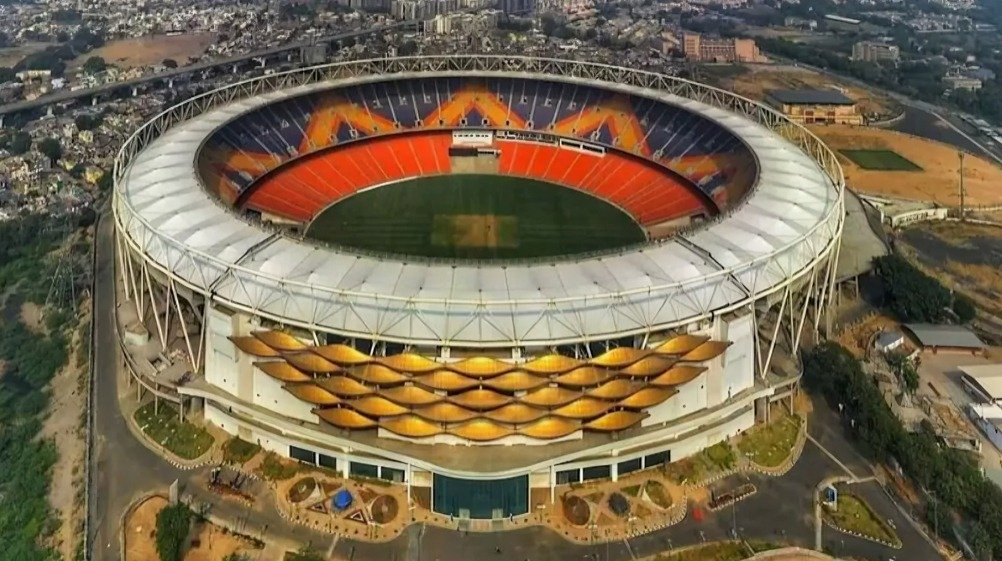Cricket is a sport that thrives on passion, history, and grandeur, and nothing symbolizes this more than the Biggest Cricket Stadiums in the World. These arenas are not just sporting venues; they are architectural marvels that define cities and carry the spirit of cricketing nations. For fans, visiting these grounds is an unforgettable experience, a pilgrimage to the temples of the game.
When discussing the Biggest Cricket Stadiums in the World, it is important to recognize both their massive capacities and the cultural significance they hold. From India’s cricketing shrines to Australia’s legendary venues, each of these stadiums tells a unique story of heritage, design, and sporting glory.
Here are the Top 10 Biggest Cricket Stadiums in the World:
10. Adelaide Oval, Adelaide, Australia

Adelaide Oval is one of the most picturesque grounds and has a capacity of 53,583, making it a prime entry in the Biggest Cricket Stadiums in the World. Established in 1871, this venue beautifully combines heritage with modern architecture. Located near the River Torrens, its scenic surroundings make it one of the most attractive sporting arenas globally, especially when hosting Ashes Tests and World Cup matches.
In the context of the Biggest Cricket Stadiums in the World, Adelaide Oval stands out because it has preserved its iconic grassed hill area, once used by families for picnics, alongside state-of-the-art pavilions. Its redevelopment added modern features without losing historical charm, making it a stadium where both tradition and innovation coexist.
| Stadium | Location | Capacity | Year Built |
|---|---|---|---|
| Adelaide Oval | Adelaide, Australia | 53,583 | 1871 |
9. DY Patil Sports Stadium, Navi Mumbai, India
DY Patil Sports Stadium in Navi Mumbai, with a seating capacity of 55,000, is one of the most versatile entries among the Biggest Cricket Stadiums in the World. Designed by Hafeez Contractor, it set new benchmarks in Indian sports architecture when it opened in 2008. Known for its German-imported cantilevered roof, the stadium provides clear sightlines from every seat, ensuring that no spectator misses the action.
As part of the Biggest Cricket Stadiums in the World, DY Patil Stadium has hosted Indian Premier League matches, cultural programs, and international concerts. The facility demonstrates how modern Indian stadiums can be multi-purpose hubs, blending sports with entertainment. Its innovative design and wide-ranging use make it a vital part of India’s cricketing infrastructure.
| Stadium | Location | Capacity | Year Built |
|---|---|---|---|
| DY Patil Sports Stadium | Navi Mumbai, India | 55,000 | 2008 |
8. Jawaharlal Nehru Stadium, Kochi, India

Jawaharlal Nehru Stadium in Kochi, built in 1966, has a seating capacity of 55,000, placing it firmly among the Biggest Cricket Stadiums in the World. Known locally as the Kaloor Stadium, it has been a hub for both cricket and football, as well as hosting concerts and cultural gatherings. Its unique Galvalume-sheet roof, supported by M.S. trusses, makes it structurally durable and visually distinct.
As one of the Biggest Cricket Stadiums in the World, this venue has also emphasized sustainability. Its roofing design allows for solar panel installation, an eco-friendly measure that highlights the stadium’s progressive approach. Its electrifying atmosphere during matches, particularly with Kerala’s enthusiastic fans, makes it one of India’s most lively cricketing venues.
| Stadium | Location | Capacity | Year Built |
|---|---|---|---|
| Jawaharlal Nehru Stadium | Kochi, India | 55,000 | 1966 |
7. Greenfield International Stadium, Trivandrum, India
The Greenfield International Stadium in Trivandrum is a modern venue with a capacity of 55,000, earning its place in the Biggest Cricket Stadiums in the World. Built in 2014, it was India’s first DBOT (Design, Build, Operate, and Transfer) stadium, with private ownership for its initial 15 years before transferring to the Kerala Cricket Association. Its innovative design reflects India’s evolving sports infrastructure.
When speaking of the Biggest Cricket Stadiums in the World, the Greenfield Stadium stands apart due to its diverse offerings. It features indoor sports facilities, an Olympic-size swimming pool, a spa, and recreational areas, making it more than just a cricket ground. The stadium’s scenic location adds to its charm, providing spectators with a unique experience.
| Stadium | Location | Capacity | Year Built |
|---|---|---|---|
| Greenfield International Stadium | Trivandrum, India | 55,000 | 2014 |
6. Rajiv Gandhi International Cricket Stadium, Hyderabad, India

With a capacity of 60,000, the Rajiv Gandhi International Cricket Stadium in Hyderabad is an important name among the Biggest Cricket Stadiums in the World. Established in 2004, it is home to the Sunrisers Hyderabad IPL team. The stadium is well known for its temple, which was built inside the complex to reverse the supposed Vastu-related “jinx” that fans believed once plagued the team’s fortunes.
As one of the Biggest Cricket Stadiums in the World, this ground combines spiritual belief with modern cricketing amenities. The venue is famous for its excellent pitch, lively crowd, and ability to host both domestic and international tournaments. It reflects the deep connection between cricket and culture in India.
| Stadium | Location | Capacity | Year Built |
|---|---|---|---|
| Rajiv Gandhi International Stadium | Hyderabad, India | 60,000 | 2004 |
5. Perth Stadium, Perth, Australia
Perth Stadium, also known as Optus Stadium, opened in 2017 with a capacity of 60,000, making it one of the Biggest Cricket Stadiums in the World. Located beside the Swan River, it offers breathtaking views of Perth and provides fans with world-class facilities. Its construction revitalized an unused area, transforming it into a thriving sports and cultural hub.
As part of the Biggest Cricket Stadiums in the World, Perth Stadium is equipped with cutting-edge technology, including LED lighting and advanced acoustics. It is a multipurpose venue that hosts cricket, AFL, rugby, and concerts, reflecting Australia’s emphasis on versatile sports infrastructure. Its modern design and fan-friendly features place it among the world’s elite stadiums.
| Stadium | Location | Capacity | Year Built |
|---|---|---|---|
| Perth Stadium | Perth, Australia | 60,000 | 2017 |
4. Shaheed Veer Narayan Singh International Cricket Stadium, Raipur, India

The Shaheed Veer Narayan Singh International Cricket Stadium, built in 2008, has a seating capacity of 65,000 and ranks high among the Biggest Cricket Stadiums in the World. Named after a local freedom fighter from Chhattisgarh, the stadium embodies both historical reverence and sporting progress. It is used as a secondary home ground for Delhi Capitals in the IPL.
As one of the Biggest Cricket Stadiums in the World, Raipur’s venue is known for its excellent seating design and facilities despite limited exposure to international matches. It serves as a beacon of sporting pride for central India and continues to grow in stature with each domestic and T20 tournament it hosts.
| Stadium | Location | Capacity | Year Built |
|---|---|---|---|
| Shaheed Veer Narayan Singh Stadium | Raipur, India | 65,000 | 2008 |
3. Eden Gardens, Kolkata, India
Eden Gardens, with a capacity of 66,349, is among the most historic names in the Biggest Cricket Stadiums in the World. Established in 1864, it is India’s oldest cricket ground and often called the “Mecca of Indian cricket.” From World Cup matches to epic Test encounters, Eden Gardens has seen it all.
As one of the Biggest Cricket Stadiums in the World, Eden Gardens is known for its passionate fans, towering stands named after cricketing legends, and iconic atmosphere. Matches here often feel like festivals, and the roar of the Kolkata crowd has influenced many results. The stadium is a perfect example of cricket’s cultural and emotional power in India.
| Stadium | Location | Capacity | Year Built |
|---|---|---|---|
| Eden Gardens | Kolkata, India | 66,349 | 1864 |
2. Melbourne Cricket Ground (MCG), Melbourne, Australia
The Melbourne Cricket Ground, affectionately called “The G,” is a colossus with a seating capacity of 1,00,024, making it one of the Biggest Cricket Stadiums in the World. Built in 1853, it has hosted Olympic Games, Commonwealth Games, and cricket World Cup finals, making it one of the most versatile stadiums globally.
As part of the Biggest Cricket Stadiums in the World, the MCG is also home to the National Sports Museum, where visitors can explore Australia’s sporting heritage. Its innovative roofing and atriums, combined with a glorious history, make the MCG more than just a venue—it is an institution in itself.
| Stadium | Location | Capacity | Year Built |
|---|---|---|---|
| Melbourne Cricket Ground | Melbourne, Australia | 1,00,024 | 1853 |
1. Narendra Modi Stadium, Ahmedabad, India

The Narendra Modi Stadium in Ahmedabad tops the list of the Biggest Cricket Stadiums in the World, with an astonishing capacity of 1,32,000. Originally built in 1983 and completely rebuilt in 2020, it features column-free seating for unobstructed views, earthquake-resistant design, and a lightweight PTFE roof membrane.
As the largest among the Biggest Cricket Stadiums in the World, it is directly connected to Ahmedabad’s metro via a skywalk, ensuring smooth transportation for massive crowds. This stadium not only hosts international cricket matches but also cultural and political gatherings, showcasing its multi-functional capabilities on a global stage.
| Stadium | Location | Capacity | Year Built |
|---|---|---|---|
| Narendra Modi Stadium | Ahmedabad, India | 1,32,000 | 1983 (Rebuilt 2020) |
FAQs:
Q1: Which is the largest among the Biggest Cricket Stadiums in the World?
The Narendra Modi Stadium in Ahmedabad, India, is the largest with a seating capacity of 1,32,000 spectators.
Q2: How many of the Biggest Cricket Stadiums in the World are in India?
Seven out of the ten are located in India, highlighting the nation’s unmatched love and infrastructure for cricket.
Q3: Why are the Biggest Cricket Stadiums in the World so significant?
They are important not only for their crowd capacity but also for shaping cricket culture, offering modern facilities, and symbolizing sporting pride.
READ MORE:



